
| Print | Back |  |
January 6, 2014 |
 |
Moments in Art Folk Paintings, a Varied Bouquet, Part Oneby Lawrence Jeppson |
Since writing about Chuck and Jan Rosenak two “Moments” ago, I have had great delight going through their monumental encyclopedia of 20th Century American folk artists page by page, again and again.
The big book is a combination of fun and good scholarship.
I am fascinated by the breadth and intensity of this diverse collection of artistic expression by men and women who have used unsophisticated means (in the usual art terms) to convey their feelings and their views of the world.
Some people have the gift and the necessity to express themselves in some visual form. My watercolorist daughter, Anne Bradham, who is far removed from being a folk artist, once said that when she cannot paint, she becomes mean, an exaggeration. For some individuals, their art is a hobby. But for many of the folk artists in the Rosenaks’ book, artistic expression is a compulsion.
The dustcover of the Rosenaks’ big book, which I depicted two weeks ago, illustrates a painting by John William (“Uncle Jack”) Dey, Acupuncture Pitchfork Style.
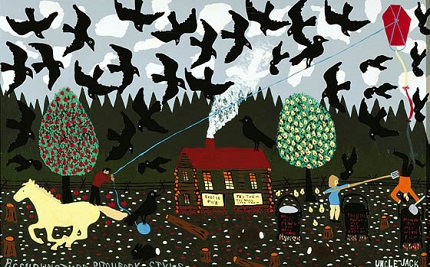
Dey, born in Hampton, Virginia, in 1912, dropped out of high school, decided to see what the rest of the world was about, spent two years in Maine, returned to Richmond, Virginia, became a barber, joined the police force, and retired in 1955. He became known as Uncle Jack when he repaired the toys of neighborhood children.
Retirement was boring. He took up painting, giving away his work until his doctor accepted his paintings in lieu of fees. Soon a Richmond folk art dealer began promoting and selling Dey’s work, although Dey’s wife decided which paintings were kept and which went to market. He may have painted 650 works.
According to the Rosenaks, “Dey’s paintings told stories from his life but also showed imagined adventures and fanciful daydreams. Many of his story/paintings were full of friendly animals and people he admired, but Dey did not hesitate to punish people he did not like by portraying them stuck on pitchforks. Some of the paintings give a sense of impending danger, with black crows hovering over all.”
Dey’s sense of humor often pops out. Like many folk artists, he sometimes turned to Biblical subjects. His depiction of the Garden of Eden has Eve saying to Adam, “Please just try it. You’ll like it.”
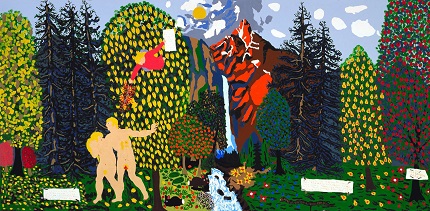
Some of these American folk artists were born in other countries. Louis Monza was born in Italy in 1897, and apprenticed as a furniture carver. With Europe in turmoil in 1913, and destined to become worse, Monza decided to emigrate.
He became a railway hand so he could discover his new country. He joined the U.S. Army, served in Panama, became a house painter in New York City, and suffered a permanent spinal injury when he fell from a scaffold. He had some gallery showings before moving to Redondo Beach, California, in 1946. He married the next year. His wife supported them while he painted.
Age turned him to pacifism and socialism, and “he became best known for his allegorical depictions of the horrors of fascism and the carnage of Europe during the two world wars.” He was prodigious, producing more than a thousand works, including sculptures.
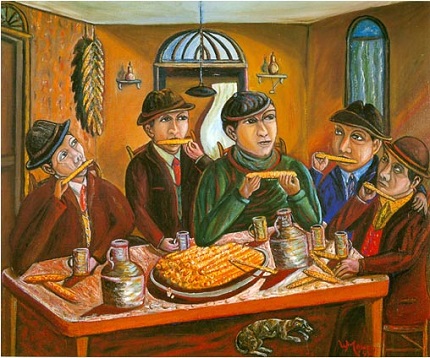
John (“Jack”) Savitsky, born 1910, New Philadelphia, Pennsylvania, quit school after the sixth grade. Known as “Coal Miner Jack,” he “documented the life and hardships of the Pennsylvania coal miner through his sharp and colorful drawings.” (Rosenak). He wrote on the back of a 1975 self-portrait:
Worked in the coal mines 50 years,
and five years as a coal breaker.
I went to school.
I went to church.
I went to work.
And on pay day, I went out and got drunk.
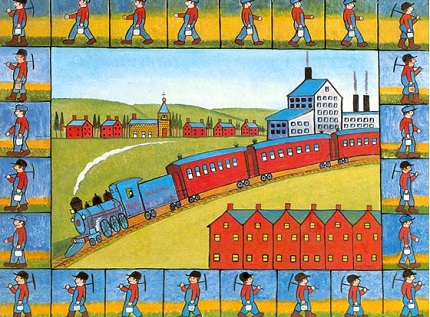
When the coal mines closed down in 1959, Savitsky’s newspaperman son suggested he take up painting. He became friends with Sterling Strauser, an accomplished painter who took an interest in folk artists by exhibiting them at local fairs and flea markets. Savitsky’s work included Biblical depictions, including interpretations of Adam and Eve.
Emma Serena Dillard Stoval (1887-1980) grew up in Lynchburg, Virginia. She became known as “Queena” because of her childhood attempts to pronounce Serena. She left high school her senior year. As Chuck Rosenak observed, Southern ladies were not expected to seek higher education. I have similar observations from living in the Near South.
“Stovall grew up in a southern home where ladies of the middle class were expected to cook, keep house, do farm chores, raise large families, and not concern themselves with other matters. She did what was expected of her until she became a great-grandmother, when, at the age sixty-two she suddenly discovered she had a ‘gift to paint.’”
Queena took an art course in Randolph-Macon Women’s College in Lynchburg in 1949. Thus a talent was born. (I am well acquainted with this extraordinary school. One of my granddaughters, Christina Stoddard, graduated from it with all the honors. Christie now edits an esoteric learned journal at Vanderbilt University in Nashville, Tennessee.)
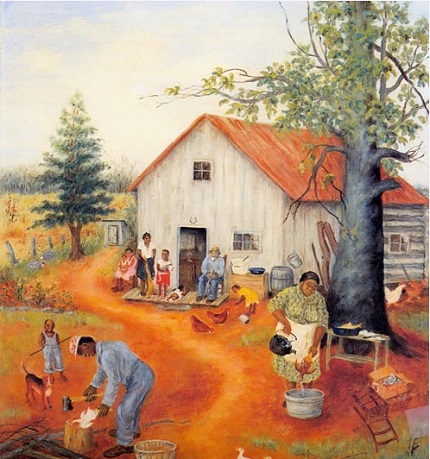
I’ll continue my exploration of folk art in next week’s Moments in Art: “Folk Paintings, a Varied Bouquet, Part Two.” There is just too much good stuff to walk off from without one more venture.
For instance, did you know that a well-known folk artist was named after a German sewing machine?
| Copyright © 2024 by Lawrence Jeppson | Printed from NauvooTimes.com |